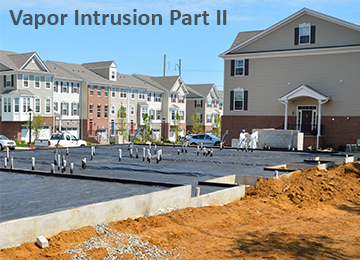In Part I of vapor intrusion, we discussed the vapor of vapor intrusion. In this part, we will discuss the intrusion part of the equation. But before we do, we need to step back briefly, to rehash what it means to be a volatile organic compound (VOC). Remember these are hydrocarbons that move rather easily from water and soil into the atmosphere around them. So if there has been a spill or release and the VOCs are attached to the soil particles or dissolved in the groundwater, they “want to leave” the soil and groundwater. So begins the journey of vapors “intruding into your space.”
We know these VOCs are not alive, but for the sake of this piece, let’s assume that our VOC molecule is named Vic. Vic wants to leave the confines of the groundwater he has been dissolved in and move on with his life. One day this happens, and Vic finds himself in fresh air above the water table surface (fresh is a relative term considering the atmosphere above the water table where Vic lives is really pretty stinky at this moment, if you know what I mean). Because Vic cannot move on his own, he gets bumped upward by the next VOC molecule leaving the water, then the next, and the next. We call this diffusion. Remember your middle school chemistry class when the teacher removed the top to her perfume bottle. By the end of the class even the kids asleep in the back row could smell it. Diffusion is molecules moving from an area of high concentration to low concentration.
Vic’s friends continue to push him up. He has moved 20 or 30 feet up through the soil. As he’s pushed out of the soil and into the air, there are billions and billions of his friends behind him. Some of his friends are released into the air and are free to move where the winds take them. Unfortunately for Vic, as he moves into the air above the soil, he encounters a hard surface: a concrete slab. Someone had the nerve to construct a building right over where he left the soil. As hard as he tries, the slab does not give. He moves right and left, but hits footings turned down in the soil. He is trapped like rat in a trap. His friends behind him continue to enter this same confining space, oblivious to their fate.
One day Vic and his VOC friends find a crack in the slab. Some have been lucky and have found a cold joint between two pieces of the slab. They scramble through the tiny space, again being pushed by friends from behind (move on, hurry up, get out of my way slow poke). Every now and then, they are almost sucked upward through the crack, as the wind outside blows across the roof of the building (chimney effect). Eventually they make it through the crack, through the cold joint, through holes in the brick wall. They enter the space from all angles and directions. Like a swarm of ants, they enter the new found air space…free at last…in your basement, or your office, or your warehouse. You have now been intruded. Are you holding your breath?
Next time, we will discuss, why Vic and his friends are such nuisance. Keep holding your breath.
About the Author: John Stewart, PG, CPG
Mr. Stewart is a Chief Geologist for ECS. He has conducted hydrogeologic site investigations at a variety of sites including NCDOT Right-of-Way corridors, Brownfields properties, landfills, industrial sites including textile and furniture plants, machine shops, chemical manufacturing plants, commercial shopping facilities, dry cleaners, and gasoline stations.

